The Surface 3 Review
by Brett Howse on May 4, 2015 9:00 AM ESTSystem Performance
Since the Surface 3 is a tablet that can replace your laptop, comparisons will be made between both devices. Because the new tablet is running full Windows 8.1 x64, it is possible to run the full benchmark suite that we have for laptops. On the tablet side, there are not a lot of cross-platform benchmarks so the only thing that can really be used is browser based tests. It is not ideal, but we have to work with what we have.
To summarize the Surface 3, it is powered by the top model of the latest Intel Atom 14nm stack. The Atom x7-Z8700 is a quad-core processor with a base frequency of 1.6 GHz. The CPU can turbo up to a maximum of 2.4 GHz, and all of this is done within a 2 watt Scenario Design Power. The review unit that I received is the $499 unit, so it only has 2 GB of LPDDR3 memory rather than the 4 GB offered on the higher priced model.
For comparisons against tablets, I have selected a sampling of several devices that have already been reviewed. Some of the devices are running on ARM processors, and several of the Windows ones run on Intel Core M, with a few more running on previous Atom architectures. To compare this device against any other device we have tested, please check out our Mobile Bench.
Tablet Performance
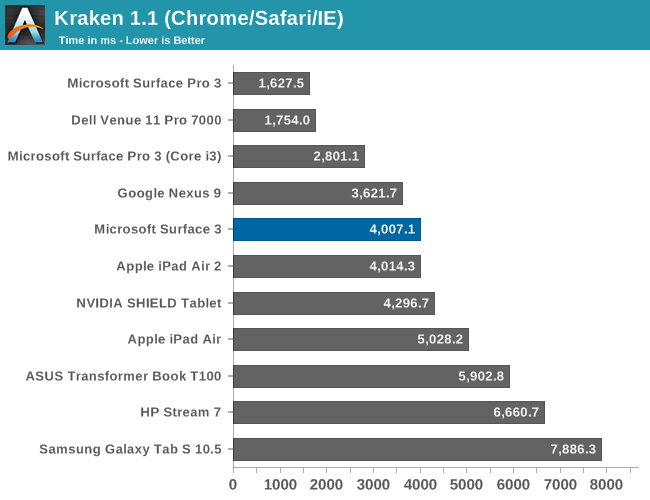
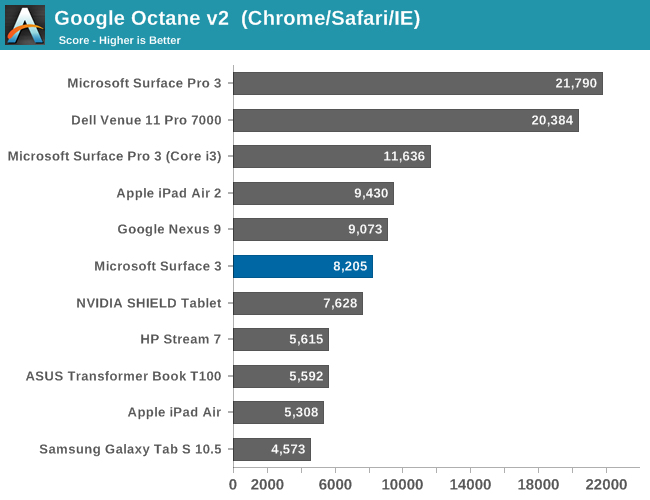

Since we just have web benchmarks to compare against other platforms, it does make it difficult to get a true feel for how Atom compares to the best, but when comparing to ARM processors it is fairly competitive. All of the web benchmarks are done using Chrome (hopefully we can switch to Microsoft Edge soon) because IE 11 has pretty awful javascript performance. Atom is a long ways off of the Core series in the Surface Pro line, and well back of the Core M powered Dell Venue 11 Pro tablet. There is a big jump in performance compared to the Bay Trail ASUS T100 and HP Stream 7. That is important since Cherry Trail is not a big architecture update, but mostly a process shrink, so the 14 nm processes can keep everything running at higher frequencies in the same power envelope.
Laptop Performance
By attaching the keyboard, the Surface 3 becomes a pretty reasonable laptop, so to see how much of a performance drop off there is with tablet class parts, the Surface 3 was run through our Laptop suite as well. The Atom is also equipped with eMMC storage, and some of the tests like PCMark take storage into account. Other benchmarks like Cinebench and x264 are CPU only. To compare the Surface 3 against any other laptop we have tested, please use our Laptop Bench.
PCMark

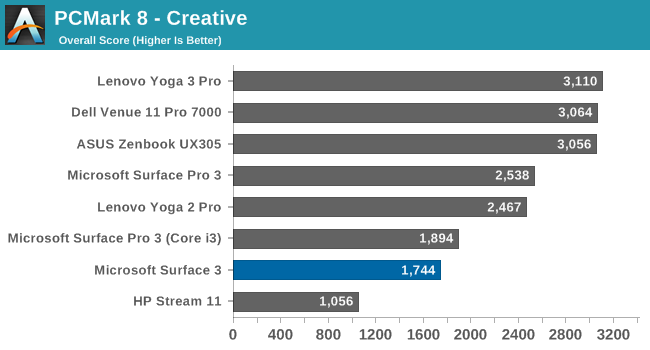
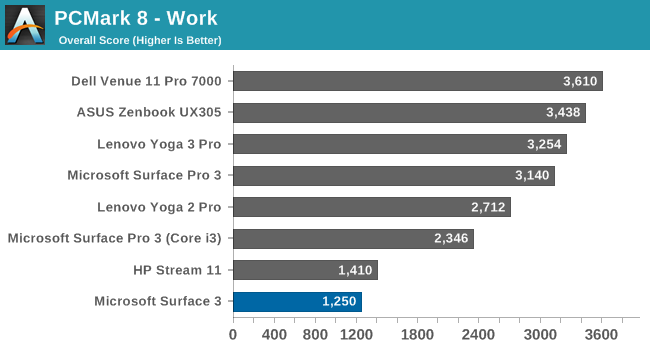
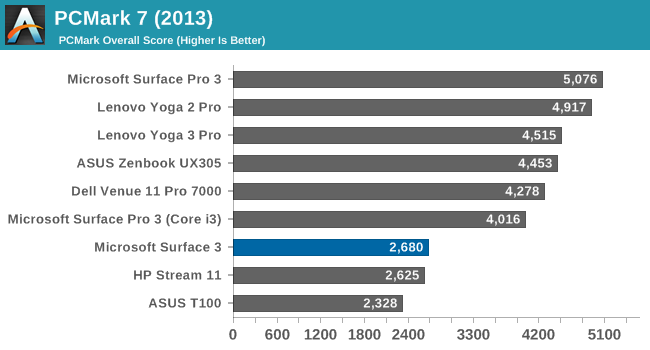
PCMark 8 from Futuremark has several benchmarks within it, all with the goal of simulating real-world use cases for each of the scenarios. It includes Home, Creative, Work, and Storage benchmarks. The workloads generally include both burst and sustained performance. The Atom can’t compete with the bigger Core pieces, but it is actually surprisingly close to the Core i3 Surface Pro 3. I think this is less about Atom and more about how handicapped Core i3 is with its lack of Turbo.
TouchXPRT


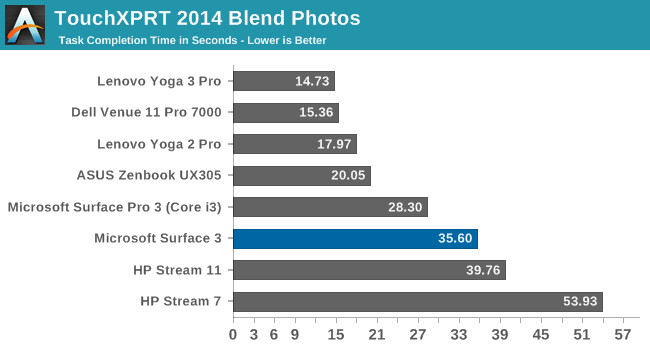
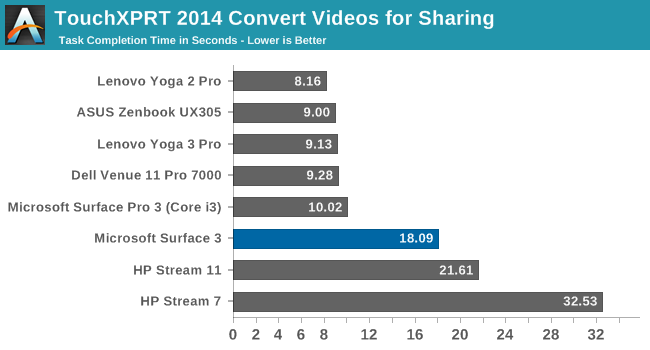
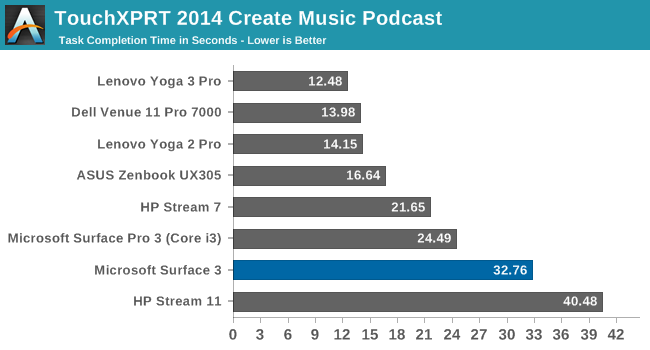
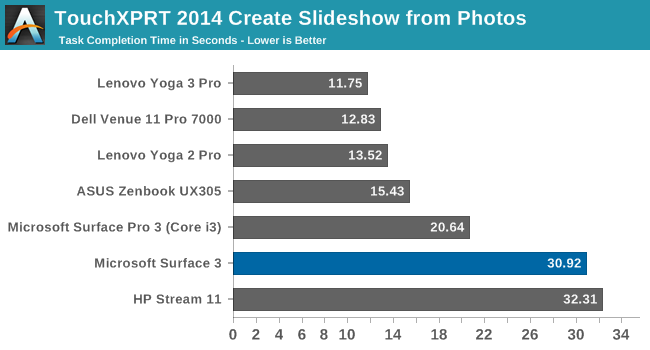
TouchXPRT 2014 is a benchmark that has a lot of burst workloads. The tasks are quick, but heavy, and it gives the processor a quick chance to cool off between each one so normally it is good about not running into throttling behaviour. The Atom processor is a long way off of the Core series here, with the exception of the i3 Surface Pro 3 which has no turbo capability. However there is a good bump in performance over the previous generation Atom in the HP Stream 7.
Cinebench

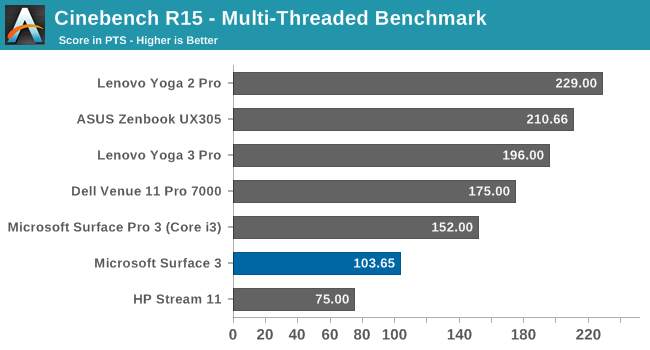
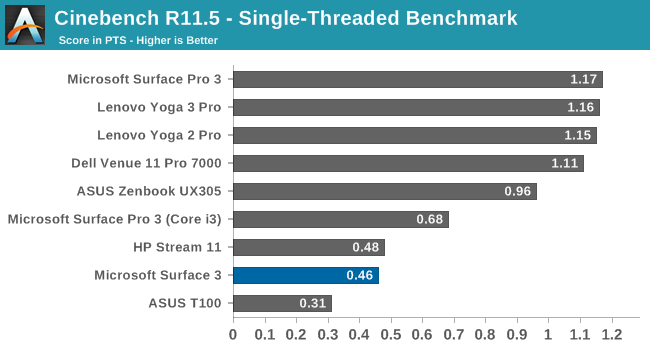
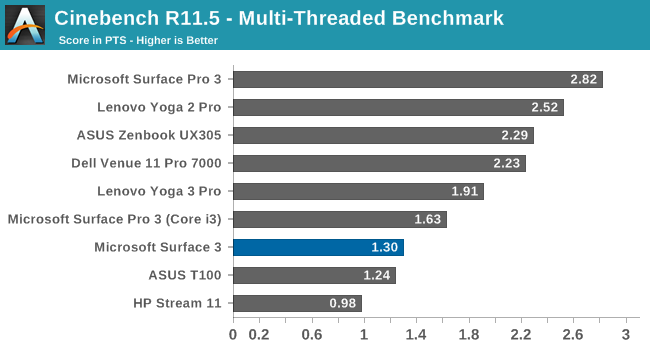
Cinebench is purely a CPU task, and it loves Instructions Per Clock (IPC) and frequency. There are two modes here with a single CPU run and all core run. It is still a long ways back of the Core i3 Surface Pro 3 on this test, and despite the Atom processor having four physical cores and the Core processors having only two physical and four logical cores, it is still not enough on the multithreaded run to really close the gap, although it does slightly. Looking at version 11.5 of this test, we have more data going back to older devices, so there are scores available from the ASUS T100 and there is a bump in performance compared to Bay Trail.
x264
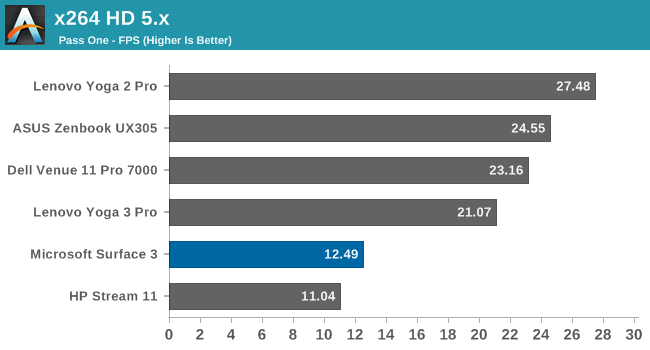

Once again this is a benchmark that prioritizes good IPC and frequency, along with multiple cores. The Atom struggles here compared to Core, which at this point should not be a surprise.
So clearly the new Cherry Trail CPU cores are not a giant leap in performance over Bay Trail, but like Haswell to Broadwell, there is a decent bump and the better manufacturing process helps increase overall performance due to the additional thermal headroom in the same power envelope. However when comparing it to the ARM competition, we only have a few data points but it does seem to be about on par with the top ARM CPUs at this time. Comparing devices across different operating systems is always difficult though.
Using the device day to day as a tablet though, performance was good. Yes, it could be better, and devices that use Core M are going to be able to run circles around Atom, but at the cost of additional heat. One of the nicest surprises of using this tablet was that it just never got warm at all, and the same cannot be said of any of the passively cooled Core M devices. Sure, when running very heavy benchmark loads, there was a bit of heat on the back, but it was never much more than around 30°C or so.
My experience was that when the Surface 3 felt slow, it was often not CPU bound but disk bound.










265 Comments
View All Comments
TremecsSTi - Friday, May 29, 2015 - link
I just found there is a very large elephant in the room that in 259 comments nobody has brought up.I had read this review and was still on the fence about what to buy but was leaning toward the iPad Air 2.
I went in to the store determined to walk out with an iPad Air 2 if nothing else so I could learn the ecosystem (This is my 3rd attempt to do so but I always balk at the cost of Apple products).
After picking up both tablets and comparing them the weight difference did not bother me as much as I thought it would. The 128/4 gb Surface 3 was $599, the 64/2 gb iPad Air 2 was $589.
Looking at the lack of ports on the iPad I started looking at accessories to be able to connect it to everything, $30 to hook it up to my monitor, $20 to hook up my camera, $30 to hook it up to my TV, $89 for a keyboard, $69, for a mouse! $829 for the iPad Air 2 and I did not even get to the covers. So I am typing this from my $718 Surface 3 ($599 + the $119 type cover) with double the ram and double the storage, micro USB, Micro SD, USB, Micro HDMI built in.
Looks like Apple lost out again but I just cannot justify the cost versus what you get. The quality of Apple products is hard to beat but the Surface 3 is very close and with twice the storage and ram for less money I could not pass it up.
blackcrayon - Saturday, May 30, 2015 - link
The Surface 3 looks like it's only about half as powerful as the GPU in the iPad, I guess if you aren't doing anything graphically intensive (games) it won't matter... Otherwise I cringe at the idea of trying a 3D game that's expecting what's normally available on Windows (i.e. Windows games aren't going to be optimized to run on such a slow GPU).khanikun - Wednesday, June 24, 2015 - link
You do know that Windows does everything a tablet does and did it before tablets were on the market? Also anyone who's invested money into any platform will have a hard time moving off that platform to another completely different platform.As for mixed bag, it's an all-in-one type device. Every single all-in-one type device has compromises. I don't have the Surface 3, but I do have the Surface Pro 3. Works great as both a tablet and as a notebook, so long as you don't actually want to use it in your lap. That's the only real downside that I find.
Now, for the Surface 3, I find it being more of a resurgence of netbooks, except in an all-in-one tablet like device. A device that can do it all, albeit not great, but well enough. Not to mention it does it not quickly, as it uses cheap internals, to keep costs down. The problem with this is the fact that MS gave it cheap internals, but decided to build a quality chassis with quality accessories. So the price point was brought down, but not down enough to satisfy everyone's wants. Sure, MS could have built this thing in a cheap plastic chassis and provided no keyboard or stylus option at all and left consumers to fend for themselves and this would have brought the price down below that of less functional iOS/Android tablets, but this would have also infuriated many consumers.
Really though, I find that MS did this right, minus the keyboard. The price point isn't unreasonable, when compared to less functional iOS/Android tablets. It's size and weight is well below that of convertible laptops. I just dislike the keyboard. Not it's feel or function, just that when you set it up in it's elevated position, it makes using the taskbar via touch, downright useless. I find myself having to remove it from the elevated position to access the taskbar via touch or use the crappy touchpad.
Ferrr - Wednesday, December 2, 2015 - link
I have a Surface 3 LTE, purchased in October 2015 with all updates duly installed. On the screen appear random clicks, like if I was touching it (but I don't) at full speed, making appear menus, opening files, starting apps etc. making the device unusable.I had reset the device to no avail.
Additionally, I experienced other problems:
- "Autorotate on" appears on the screen when working with the keyboard attached (so, not rotating at all) stopping the device for some seconds.
- A full charge needs 5-6h, with the device plugged in and switched off. If you want to work while charging the device, you will have a hard time: it charges extremely slowly (12h minimum needed) and in most of cases, if you have 2 or 3 "normal" (not very high energy consuming) apps open at the same time (outlook, word, edge), the device will keep on discharging, even plugged in.
- The device loses battery when on sleep mode at a very alarming pace (around 5% per hour)
I purchased the device in the US and I work in Russia. Now, with a worldwide guaranty, and in spite of having a filial in Russia, Microsoft asks me to ship the device, to pay for the shipping, to be delivered the new one in the US, and to pay the shipping again to my home in Russia...
And the screen problem is known since 3 years, with thousands of people complaining on forums.
Shame to Microsoft to keep on selling these crappy devices.
If you don't know how to make computers and how to deal with customers, please stay away and let others like Apple do that.
I deeply regret the day when I entered the Microsoft store to buy this.
Someone else is experience the same ordeal?
q8wii - Friday, February 19, 2016 - link
Thank you